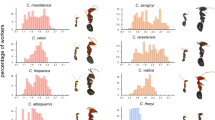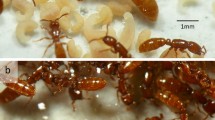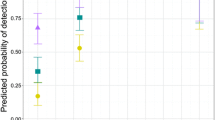Summary
Cephalotes atratus, the “giant turtle ant” of the Neotropical tribe Cephalotini, exhibits an intermediate stage in the evolution of polymorphism. The allometric growth line is straight, but the distribution of worker sizes is bimodal. An ethogram of workers in laboratory nests showed pronounced differences in behavior according to age. Under natural conditions, individual foraging specializations based on worker size were also found. Compared to other advanced cephalotines, this species appears to be less strongly adapted for arboreal life. A model is presented for the evolution of polymorphism in ants.
Resume
Cephalotes atratus, la «Fourmi-tortue géante», de la tribu néotropicale des Cephalotini, apparaît comme un stade intermédiaire dans l'évolution du polymorphisme social. La ligne de croissance allométrique est droite, mais la distribution des tailles des ouvrières est bimodale. Un éthogramme des ouvrières dans des nids artificiels montre des différences de comportement prononcées en fonction de l'âge. Dans les conditions naturelles, on observe aussi des spécialisations du comportement individuel d'approvisionnement, en rapport avec la taille des ouvrières. Comparée à d'autres Céphalotines évoluées, cette espèce semble moins fortement modifiée dans le sens de la vie arboricole. On présente un modèle d'évolution du polymorphisme chez les Fourmis.
Similar content being viewed by others
References
Beulig M.L., Janzen D.H. 1969.—Variation in behavior among obligate acacia-ants from the same colony (Pseudomyrmex nigrocincta).J. Kans. Ent. Soc., 42, 58–67.
Corn M.L., 1976.—The ecology and behavior ofCephalotes atratus, a Neotropical ant (Hymenoptera: Formicidae). Ph. D. thesis, Harvard University, Cambridge, Ma.
Creighton W.S., 1963.—Further studies on the habits ofCryptocerus texanus Santschi (Hymenoptera: Formicidae).Psyche, Camb., 70, 133–143.
Creighton W.S., 1967.—Studies on free colonies ofCryptocerus texanus Santschi (Hymenoptera: Formicidae).Psyche, Camb., 74, 34–41.
Creighton W.S., Gregg R.E., 1954. —Studies on the habits and distribution ofCryptocerus texanus Santschi (Hymenoptera: Formicidae).Psyche, Camb., 61, 41–57.
Creighton W.S., Nutting W.L., 1965.—The habits and distribution ofCryptocerus rowheri Wheeler (Hymenoptera; Formicidae).Psyche, Camb., 72, 59–64.
Fagen R.M., 1974.—Theoretical bases for the evolution of play in animals. Ph. D. thesis, Harvard University. Cambridge, Ma.
Higashi S., 1974.—Worker polyethism related to body size in a polydomous red wood ant,Formica (Formica) yessensis Forel. J.Fac. Sci. Hokkaido Univ. (Ser. 6),19, 695–705.
Horstmann K., 1972.—Untersuchungen zur Grossverteilung bei den Aussendienstarbeiterinnen der WaldameiseFormica polyctena Foerster (Hymenoptera, Formicidae).Waldbygiene, 9, 193–201.
Horstmann K., 1973.—Untersuchungen zur Arbeitsteilung unter den Aussendienstarbeiterinnen der WaldameiseFormica polyctena Foerster.Z. Tierpsychol., 32, 532–543.
Kempf W.W., 1951.—A taxonomic study of the ant tribe Cephalotini (Hymenoptera: Formicidae).Revta Entomol., Rio J., 22, 1–244.
Kempf W.W., 1973.—A newZacryptocerus from Brazil, with remarks on the generic classification of the tribe Cephalotini (Hymenoptera: Formicidae).Studia Entomol., 16, 449–462.
Lindauer M., 1952.—Ein Beitrag zur Frage der Arbeitsteilung im Bienenstaat.Z. vergl. Physiol., 34, 299–345.
Lindauer M., 1961.—Communication among social bees. Harvard University Press, Publ., Cambridge, Mass., 143 p.
Otto D., 1958.—Uber die Arbeisteilung im Staate vonFormica rufa rufo-pratensis minor Gossw. und ihre verhaltensphysiologischen Grundlagen: Ein Beitrag zur Biologie der Roten Waldameise.Wiss. Abb. dt. Akad. Land.-Wiss. Berl., 30, 1–169.
Sokal R.R., Rohlf F.J., 1969. — Biometry. W. H. Freeman and Co., Publ., San Francisco, 776 p.
Weber N.A., 1957. — The nest of an anomalous colony of the arboreal antCephalotes atratus.Psyche, Camb., 64, 60–69.
Wilson E.O., 1953.—The origin and evolution of polymorphism in ants.Q. Rev. Biol., 28, 136–156.
Wilson E.O., 1971.—The Insect Societies.Belknap Press of Harvard University Press, Publ., Cambridge, Mass. 548 p.
Wilson E.O., 1975.—Leptothorax duloticus and the beginnings of slavery in ants.Evolution, 29, 108–119.
Wilson E.O., 1976a.—A social ethogram of the Neotropical arboreal antZacryptocerus varians (Fr. Smith).Anim. Behav., 24, 354–363.
Wilson E.O., 1976b.—Behavioral discretization and the number of castes in ant species.Behav. Ecol. Sociobiol., 1, 141–154.
Wilson E.O., Fagen R.M., 1974.—On the estimation of total behavioral repertoriesin ants.J. N. Y. Entomol. Soc., 82, 106–112.
Author information
Authors and Affiliations
Rights and permissions
About this article
Cite this article
Corn, M.L. Polymorphism and polyethism in the neotropical antCephalotes Atratus (L.). Ins. Soc 27, 29–42 (1980). https://doi.org/10.1007/BF02224519
Received:
Accepted:
Issue Date:
DOI: https://doi.org/10.1007/BF02224519




